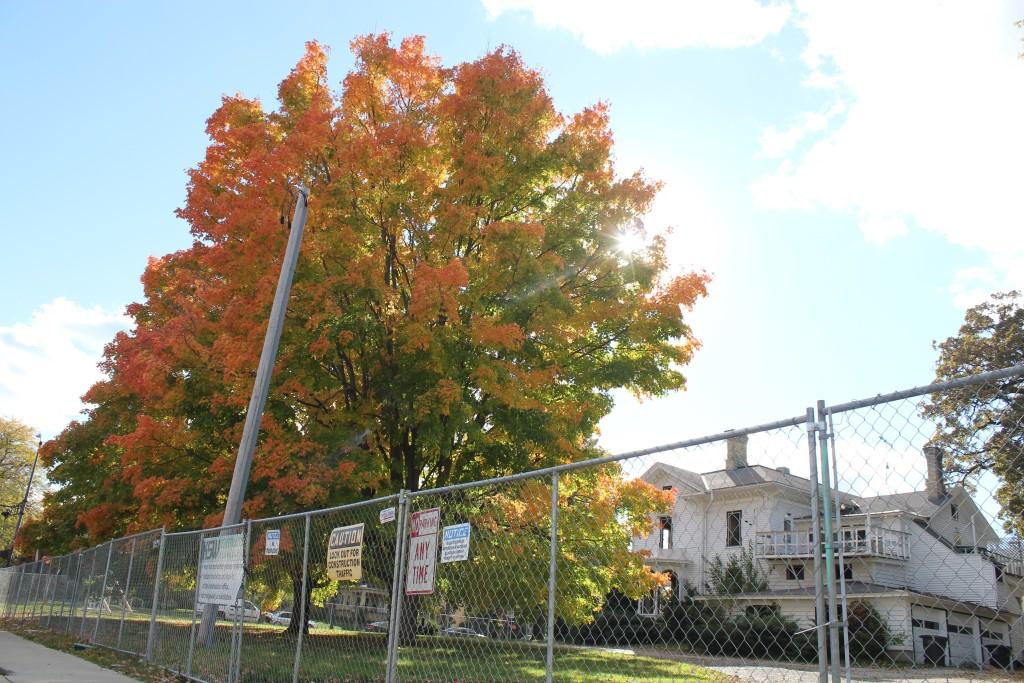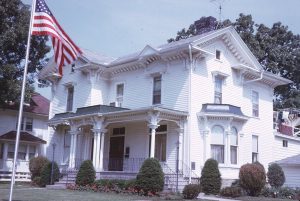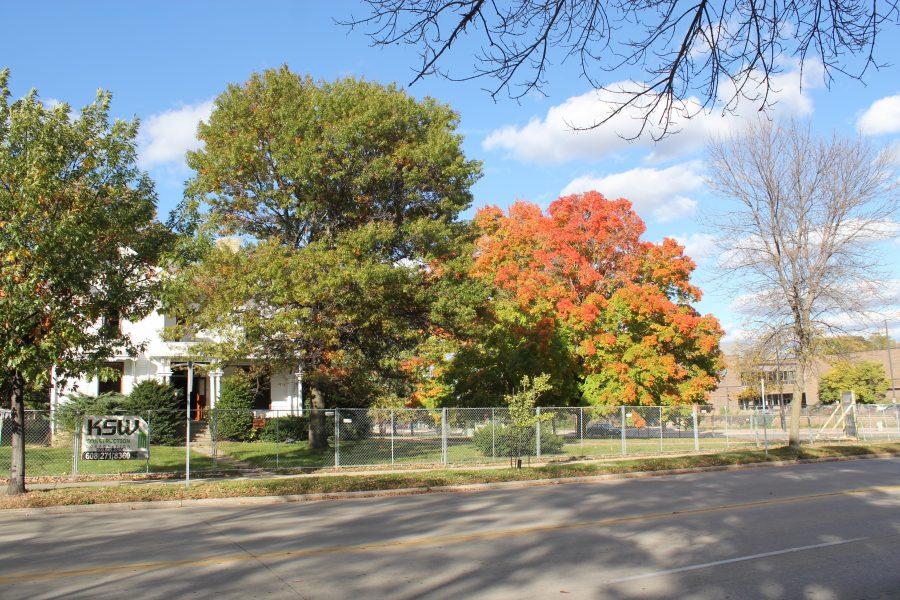Online petition creates buzz over tree removal
By Vesna Brajkovic
Oct. 20, 2015
Two maple trees that garnered a lot of attention this past week were taken down in the middle of the night last Saturday, marking the start of the development of a nine-unit townhouse to replace the old Olsen Funeral Home on the corner of W. Main and Prince Street.
Demolition started on the home on Oct. 19, tearing down the north side of the building with an excavator.
After the chain-link fence went up around the property of 1014 W. Main St., which features a vacant 142-year-old Italianate home, two “landmark” maple trees and a bur oak that’s around 200 years-old, community concern seemed to grow for the future of the corner spot. A sign that reads “Campus Edge Apartments: Move-In June 2016” sits facing the intersection.

A student-made petition aiming to prevent the destruction of the two trees on the property, facilitated by change.org, received 1,924 signatures from UW-Whitewater students, alumni, community members and friends of the cause in less than a week.
“As part of the Urban Forestry Commission, I am thrilled that this young woman [senior Amber Levenhagen] took the time to take action on this and tried to save those trees even though it didn’t turn out that way,” said Urban Forestry Committee and Planning & Architectural Review member Sherry Stanek. “It’s really encouraging to me to see that kind of passion when it comes to our environment.”
UW-Whitewater sustainability coordinator Wesley Enterline said the attention this particular petition reached was not surprising because it was “started by a student and traveled quickly through social media.”
“Online petitions are a form of ‘armchair activism’ that lends itself well to social media,” Enterline said in an email to Royal Purple.
Effort to preserve the bur oak
The efforts of the petition have now shifted to preserve the around 200-year-old bur oak in the back of the property after the maples were taken down.
“The closer I got to it, the smaller I felt,” Stanek said. “I get chills thinking about it. I felt like a toddler.”
Stanek said she is looking to nominate the oak for Wisconsin’s Champion Tree Program, which designates the tree as a significant historical feature under protection. The nomination will ideally be sent with the property owner’s consent.
“What do we value?” said Dale Kaminski, director of the Arts Media Center. “It’s easy to say ‘economic development.’ But trees, and landscape and our environment seem to take a backseat to that. It seems to me that this is kind of a bellwether situation that’s happening right here in our own community. What do we value in this community? It speaks directly to that.”
Community members are welcome to attend the next Urban Forestry Commission meeting, on at 4:30 p.m. Oct. 27 in the second floor conference room of the Whitewater Municipal Building where they will be discussing the Champion Tree Program.
“Each time that we were both at a [Planning & Architectural Review] meeting I told [Ryan Hughes, the developer]… that I would really recommend he work to keep that oak tree and he seemed sympathetic to that,” Stanek said. “It had more to do with him being able to develop his property. But he is not insensitive to the idea of trying to save the oak tree. We knew the maples were going to go because they basically took up half of the lot.”
In May, Hughes said he “looked into keeping the large oak tree” but the insurance company says it’s too old and unsafe, according to the May 14, 2015 Common Council meeting agenda.
Plans approved in May
Originally aimed at city manager Cameron Clapper, the petition was revised to be directed to Hughes after it was known that the city government, including the Urban Forestry Committee, do not have control over tree removal on private property.
The development was approved in May by the commission and the Common Council after public hearings were provided throughout the process.
“It is important to be involved in the affairs of city development in the early stages rather than the eleventh hour,” Enterline said. “This issue was non-existent until the fences were put up, which was a clear indication that the trees were threatened, when in fact the fate of these trees were sealed in a city planning meeting over a year ago.”
The only mention of preservation of natural features in the proposal application is a standard that states “the proposed development will be compatible with and preserve the important natural features of the site.” To which Hughes noted “correct” and later “The proposed project will be compatible with the natural features of the site.”
“Natural features,” depending upon definition, could include trees, according to common council representative to the Plan Commission Lynn Binnie. However, he says, the site has been designated as most appropriate for dense student-oriented housing.
“Given the fact that the property is less than an acre in size, it would be very difficult – if not impossible – to construct a good-sized residence while retaining the trees,” Binnie said. “Even if there was an attempt to preserve the trees, it is very likely that the construction might damage the roots to the extent that the trees might die.”
Historic home lost
The landscape isn’t the only thing set to be lost. The home on the property holds historical significance in the community, being a long-time funeral home.

“To put it simply, the bur oak is the key tree species in a landscape that has been essentially exterminated with European settlement in our area,” Enterline said. “It is not unrealistic to predict its age at 150-plus years old, which far exceeds the likely age of those maples that were removed. This is not a tree that can be replaced in one lifetime and its loss – along with the demolition of the house on that lot – also represents losing a piece of our community’s history.”
Before the home was the Olsen Funeral Home, it was the Hickey-Kent Funeral Home.
“That was a long-time funeral home, and the Hickey-Kent Company goes way back to when they were located on Main Street, and they were also a furniture store, so they go way back,” said Whitewater Historical Society museum curator Carol Cartwright “It was a long-term business in town, so it has some local historical interest for that.”
David Olsen, who still operates the Olsen Funeral Home through his Jefferson location, said the loss of the ‘beautiful trees” and home is heartbreaking, and to “become of aware of the controversy that this has caused” saddens him.
“It was our business for 27 years, and prior to us owning it, was another funeral home…” Olsen said. “It’s a building that has a lot character and loved by a number of people, but at some point you make a business decision to say we can still serve the [Whitewater] community without that facility.”
2014 Plan Approval Process
Hughes first proposed the Campus Edge Apartments development to the Whitewater Plan Commission in May 2014, where it did not meet the requirements for the zoning district R-3A. At the June 17, 2014 meeting with the Common Council, there was a conceptual review of the project as a Planned Development, which was presented to Plan Commission on June 9, 2014.
The plan called for a four-story building with 22 five-bedroom units, and surface and underground parking.
Public notice was sent out, and there was one public comment from a neighboring property owner who expressed support for a higher density development near campus.
In May 2015, two public hearings were held on the consideration to change the District Zoning Map and for a Conditional Use Permit. Notices were mailed to property owners and posted in the Whitewater Register. No public comment was given.
Hughes sought feedback from the plan commission and common council. Concerns on parking and density were mainly addressed, but there were also discussion on the trees and other features of the site before the plans were approved.
“Wouldn’t it be a wonderful thing if everybody wins in this situation,” Olsen said two days before the demolition of the maple trees took place. “The biggest winners of course would be the trees.”
Common Council meetings are held on Tuesdays at the Whitewater Municipal Building, 312 W. Whitewater St. All meetings are open to the public unless otherwise noted.













